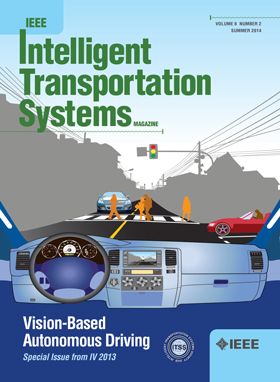基于廉价运算的人脸和面部地标联合定位的驾驶员昏昏欲睡检测
IF 7.9
1区 工程技术
Q1 ENGINEERING, CIVIL
IEEE Transactions on Intelligent Transportation Systems
Pub Date : 2024-10-08
DOI:10.1109/TITS.2024.3443832
引用次数: 0
摘要
实时检测驾驶员是否昏昏欲睡对于降低交通事故和死亡风险至关重要。目前基于面部地标的方法通常采用两阶段模式,分别对人脸和面部地标进行定位。此外,大多数方法都会受到夜间驾驶或闭眼等挑战性条件的阻碍。为了应对这些挑战,我们提出了一种名为 YOLOFaceMark 的改进型 YOLO 网络,它可以同时检测人脸及其面部地标。此外,我们还引入了基于面部地标的嗜睡检测模型。该模型利用提取的眼睛和嘴巴信息来识别昏昏欲睡的状态。我们通过结构重新参数化、通道洗牌以及设计带有隐式模块的双分支检测头,对原有的 YOLO 组件进行了优化。这些改进旨在提高准确性,同时保持计算效率。我们在 300W 和 COFW 等公共数据集上验证了 YOLOFaceMark 的实时性能和准确性。此外,我们还进行了进一步的验证,以证明我们有能力仅根据 YOLOFaceMark 检测到的面部地标实现有效、稳健的嗜睡检测。本文章由计算机程序翻译,如有差异,请以英文原文为准。
Driver Drowsiness Detection Based on Joint Human Face and Facial Landmark Localization With Cheap Operations
Real-time detection of driver drowsiness is critical to reduce the risk of road accidents and fatalities. Current facial landmark-based methods usually use a two-stage paradigm, where faces and facial landmarks are localized separately. Additionally, most methods can be hindered by challenging conditions, such as night driving or eyes closed. To address these challenges, we present a refined YOLO network named YOLOFaceMark that can simultaneously detect faces and their facial landmarks. Furthermore, we introduce a drowsiness detection model based on facial landmarks. This model utilizes extracted eye and mouth information to identify drowsy states. We optimize the original YOLO components through structural re-parameterization, channel shuffling, and the design of a dual-branch detection head with an implicit module. These enhancements are designed to improve the accuracy while maintaining computational efficiency. We validate the real-time performance and accuracy of YOLOFaceMark on public datasets, including 300W and COFW. Additionally, we conduct further validation to demonstrate our ability to achieve effective and robust drowsiness detection solely based on the facial landmarks detected by YOLOFaceMark.
求助全文
通过发布文献求助,成功后即可免费获取论文全文。
去求助
来源期刊

IEEE Transactions on Intelligent Transportation Systems
工程技术-工程:电子与电气
CiteScore
14.80
自引率
12.90%
发文量
1872
审稿时长
7.5 months
期刊介绍:
The theoretical, experimental and operational aspects of electrical and electronics engineering and information technologies as applied to Intelligent Transportation Systems (ITS). Intelligent Transportation Systems are defined as those systems utilizing synergistic technologies and systems engineering concepts to develop and improve transportation systems of all kinds. The scope of this interdisciplinary activity includes the promotion, consolidation and coordination of ITS technical activities among IEEE entities, and providing a focus for cooperative activities, both internally and externally.
 求助内容:
求助内容: 应助结果提醒方式:
应助结果提醒方式:


